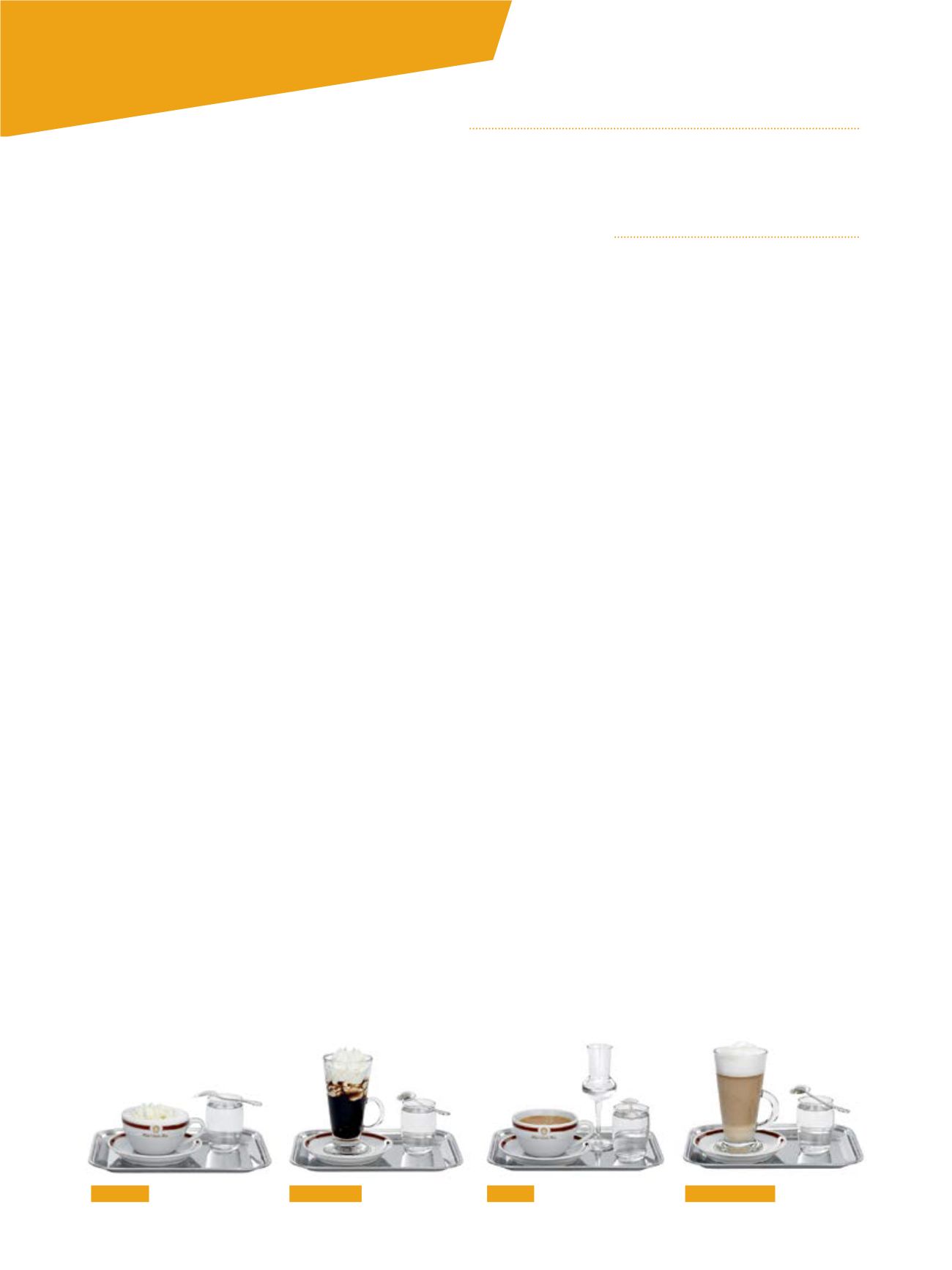
WELCOME
||
94
COFFEEHOUSECULTURE
Apieceof Vienna
inTyrol. //
MONIKAFRENZEL, PHOTOS: STÉPANEMUS/INNFOCUSPHOTOGRAPHY, TOMBAUSE
T
ypical for Viennese Coffee Houses are marble tables, on
which the coffee is served, Thonet chairs, boxes (loges),
newspaper tables and interior design details in the style of
Historicism. Viennese coffeehouses are a place, “where time and
space are being consumed but only the coffee is found on the bill”…
This is how the Club of the Viennese coffeehouse owners describes
thisunique culture–which canbe foundalso inTyrol.
History
The tradition of the Viennese Coffee House Culture goes back to the
end of the 17
th
century and is associated with the Turkish siege in
1683. When the Turkish had to flee, they left behind several sacks of
coffee. Legend has it that the Armenian spy Diodato, whowas in the
service of the court and knew everything about this “modern drink”,
founded the first coffeehouse and Georg Franz Kolschitzky ran the
first coffee bar briefly after the end of the Turkish Siege of Vienna. In
1720, the first coffeehouse started to offer newspapers. The “obliga-
tory glass of water” has been served since the beginning. Napoleon’s
Continental Blockade raised the costs of the import of coffee beans
and a solution was found with the implementation of coffeehouses.
Warmmeals and alcoholic beverages were also allowed to be served.
In1814/1815, when visitors fromnear and far rushed to the congress
inVienna, the coffeehousebecame evenmore famous. TheViennese
examplewas copiedeverywhereandbecamea synonymof lifequality
throughout Europe! In 1865, womenwere granted access to the cof-
feehouses. Before, they were only allowed as “cashiers”, who were in
charge of the distribution of sugar and accounting. The “Piccolo” had
to put out the tables andmake sure that the water glass was never
empty. Part of his jobwasalso todeliver “postillond’amour” letters, as
you obviously couldn’t expect that from the serious headwaiter, who
wasproudof callinghis guestsbynameand title.
Tyrol’s tradition
Today, twocoffeehousesarecompeting for the title “oldestoriginal cof-
feehouse in Innsbruck”. Both of them have a long, impressive history.
TheCaféKatzung inHerzogFriedrichStreet goesback to theyear1793,
when Anton Georg Katzung opened a bakery and soon afterwards
became a star chef andwas appointed the “2
nd
Court Confectioner of
the Archduchess Elisabeth”. The family history continued until the ye-
ar 2000, whenPaula, the last bearer of thename, diedand the coffee-
housewas given to the Dengg family. The coffeehouse Katzung offers
coffeehouse culture inamodernambience, butmarble tables anddif-
ferent coffeespecialitiescanstill be found. In1803, CaféMundingope-
ned inahidden spot inKiebachgasseStreet. According to this, Katzung
wouldbe10yearsolder thanCaféMunding. But: Today’s locationof the
CaféMunding iswhere thebakery of the confectioner Kirchner was si-
tuatedbefore, whichwas takenover and expandedbyNepomukMun-
ding. And confectioner Kirchner’s roots on the other hand, date back
even further. Nevertheless, thedelicaciesof the confectioner today are
still as tasty as they have always been. In summer, the garden invites
for acosy rest, away from thehustleandbustleof theOldTown.
Theclassiccoffeehouses: CaféCentral, located inGilmstraßeStreet
and open since 1884, is the typical Old Viennese Café. This 130-ye-
ar-old traditional coffeehousewith itsselectionof65newspapersand
magazines iswell-known for its relaxing atmosphere and invites for a
longer visit. Next to its diverse coffee assortment, it also offersmeals
throughout the day. Another café in Viennese style is the Café Sacher
in the street Rennweg 1, open since 2000 and known as the café of
the Imperial Palace, theHofburg. Besides itswideselectionofpastries,
it is famous for the Sacher cake, which was created by Franz Sacher
in 1832. Its original recipe is still a closely guarded secret. Not only
sweets areofferedhere. Traditional Austriandishes aswell as exquisi-
temealsarepreparedbyagourmet chef.
||
Melange
Einspänner
Fiaker
Kaffee verkehrt
„Das Kaffeehaus ist einOrt, andemman sichalsGast
nicht daheim, aber doch zuHause fühlt.“ //
“The coffeehouse isnot home,
but not out in the freshair either”.
PETERALTENBERG,WIENERKAFFEEHAUSLITERAT (VIENNESECOFFEEHOUSEPOET), 1918


